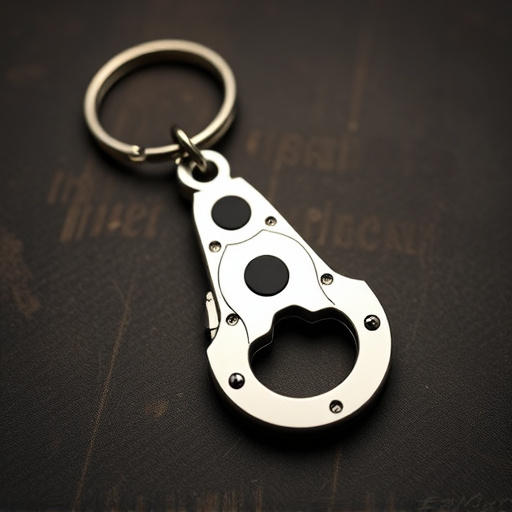Tactical keychain weapon techniques are essential for everyday carry defense, requiring learning diverse grip positions and efficient movements. A comprehensive guide should cover various holding methods, defensive stances, one-handed operations, and effective strikes on pressure points. Regular training builds muscle memory for swift responses in high-stress situations. Choosing the right tactical keychain involves understanding specific needs, EDC setup, and compatibility with tasks like self-defense, emergency opening, or multi-tooling. Practice simple yet efficient techniques to use keychains as leverage tools, distraction devices, or last-resort strike tools, while adhering to legal constraints and prioritizing safety through proper training and secure storage.
“Tactical keychains have emerged as versatile tools for everyday carry enthusiasts seeking enhanced personal defense. This comprehensive guide delves into the art of tactical keychain weapon techniques, offering an in-depth look at their effectiveness and practical applications. From understanding various deployment methods to exploring legal considerations, we provide a thorough exploration of these compact self-defense devices.
Learn how to choose the perfect tactical keychain for your needs, discover expert tips on efficient usage, and stay informed about safety precautions, making you a well-prepared individual in any situation.”
- Understanding Tactical Keychain Weapon Techniques: A Comprehensive Guide
- Choosing the Right Tactical Keychain for Your Everyday Carry
- Effective Deployment and Usage Scenarios: Tips from Experts
- Legal Considerations and Safety Precautions for Carrying a Tactical Keychain
Understanding Tactical Keychain Weapon Techniques: A Comprehensive Guide
Tactical keychain weapon techniques are an essential aspect of everyday carry defense, offering a discrete yet potent means of self-protection. Understanding these techniques involves mastering various grip positions and efficient movements to maximize the potential of your compact defense tool. By practicing and internalizing these skills, users can gain confidence in their ability to defend themselves in unexpected situations.
A comprehensive guide should cover different holding methods for various scenarios, such as defensive stances, open-hand grips, and even one-handed operations. It should also delve into effective strikes, including target areas like pressure points and vital organs, ensuring that users can employ their keychains with precision and force when needed. Regular training and drills are crucial to building muscle memory, allowing for swift and accurate responses during high-stress situations.
Choosing the Right Tactical Keychain for Your Everyday Carry
Choosing the right tactical keychain involves understanding your specific needs and the various techniques associated with it. Consider the types of tasks you require it to perform; is it for self-defense, emergency opening of doors or vehicles, or as a multi-tool? Different keychains are designed with unique features such as built-in blades, screwdrivers, or even pepper spray—each offering distinct advantages in various situations.
When selecting your tactical keychain weapon techniques, think about your everyday carry (EDC) setup and compatibility. Ensure it fits comfortably in your hand and doesn’t add bulk to your existing EDC gear. Additionally, familiarize yourself with proper handling and deployment techniques for the specific tools on your keychain. Regular training and practice will help you maximize its potential during an emergency or self-defense scenario.
Effective Deployment and Usage Scenarios: Tips from Experts
When it comes to effective deployment and usage, tactical keychains are versatile tools that can be employed in various scenarios. Experts recommend keeping your keychain weapon techniques simple yet efficient. One common approach is to use the keychain as a leverage tool during self-defense, allowing you to gain temporary control of a situation. For instance, in a pinch, you can twist and hook the keychain to disrupt an attacker’s grip on you or an object.
Additionally, tactical keychains can serve as a means of distraction or a last-resort strike tool. The sudden flash of metal and the clinking sound can startle an assailant, giving you precious seconds to escape. In close-quarters combat, a well-timed swing with a keychain can stun or temporarily disable an opponent. However, it’s crucial to practice and master these techniques to ensure their effectiveness in high-pressure situations.
Legal Considerations and Safety Precautions for Carrying a Tactical Keychain
When carrying a tactical keychain for everyday carry defense, it’s crucial to understand legal considerations and safety precautions. Each jurisdiction has specific laws regarding hidden weapons, including keychains designed as tactical tools. It’s essential to research and comply with local, state, or provincial regulations to avoid legal repercussions. Always ensure that your tactical keychain is used responsibly and only in situations where self-defense is necessary, respecting the rights and safety of others.
Safety precautions include proper training in tactical keychain weapon techniques to maximize effectiveness while minimizing risk of injury to yourself and bystanders. Practicing with a range or under professional supervision can help you become proficient in deploying and controlling your tactical keychain safely. Additionally, keeping your tactical keychain in a secure carrying case or sheath when not in use helps maintain its sharpness and prevents accidental activation that could cause harm.
A tactical keychain can be a powerful tool for everyday carry defense, offering quick access to self-protection in various situations. By understanding the different techniques and choosing the right keychain for your needs, you can effectively deploy it for personal safety. Remember to stay informed about local laws and always prioritize safety when carrying any defensive device. Embrace the knowledge gained from this guide, and be prepared to defend yourself with confidence.
